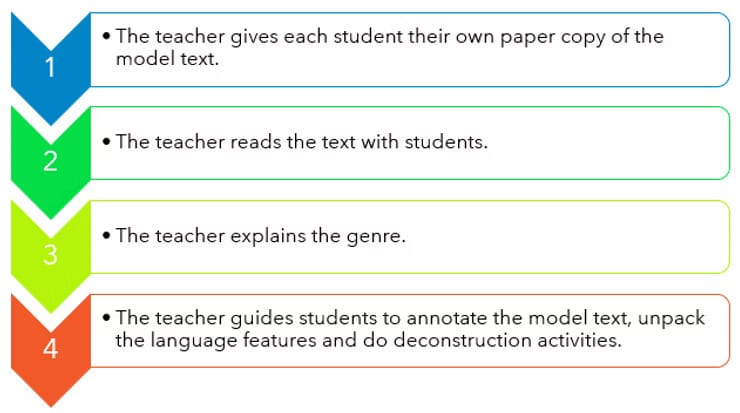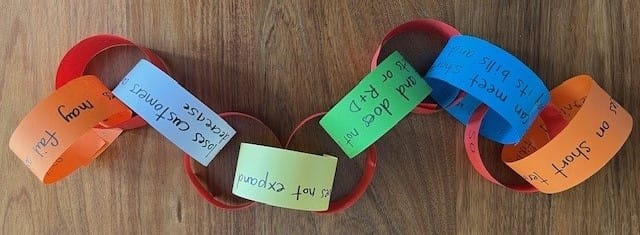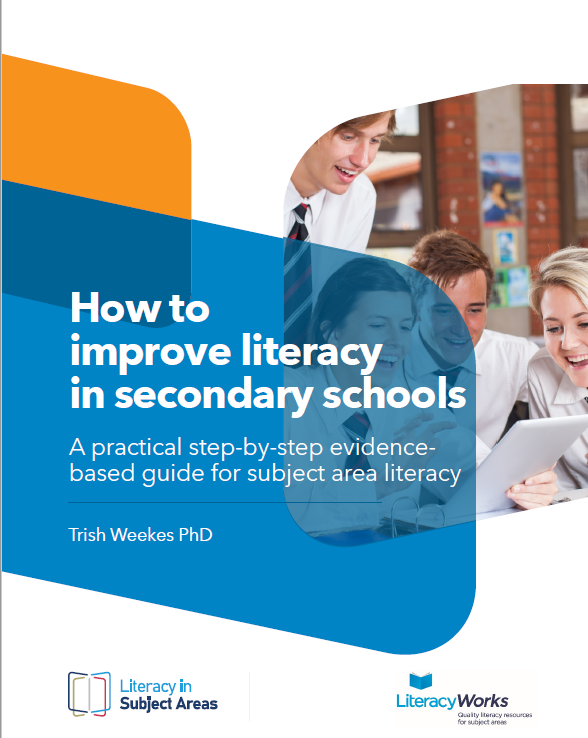Your cart is currently empty!
Author: Trish





It’s a quick Teaching and Learning Cycle that should take around 20 minutes. Since it’s short, we will be asking students to write a short paragraph of around 3 sentences… but they will be good sentences.
2. Prepare a model text
Write a model text of a few sentences about ONE of the things e.g. one cause, one effect, one source, one design. Identify the features that students will annotate (e.g. the job of each sentence, cause and effect language for explaining, technical terms for descriptions, meaning verbs for sources ie shows, means, reveals, illustrates)
Print one paper copy of the model text for each student. You should be able to fit several on one A4 page.
Give students a piece of paper and ask students to write about the a topic/image/ stimulus without any support. This is the pre-test and it’s not supposed to be good. I’ve seen students write a few words or nothing at all for a pre-test and that’s fine.
2. Modelling
Give out the paper model texts. Read the text and ask students to annotate with the features you prepared.
3. Supported writing
Give students the second topic, second source or second design. Ask them to write a text with a peer in pairs or groups using the same features as the model text.
4. Independent writing
Give the students the first topic again, the one they did in the pre-test. That’s the independent text. Ask them to re-write their text now that they know what to do.
5. Evaluate
Ask students to swap their text with a peer and evaluate how much the text has improved. It could be longer, contain more technical terms, be more accurate. It should be a positive experience and you can discuss how much the students have improved.
If you do this activity regularly, I swear that you’ll see improvement in your students’ confidence and ability to write like subject experts.

We all know that students need to learn to write like a subject expert, but they also have to learn to speak like a subject expert too.
If they can’t speak about it, they surely can’t write about it.
Research shows that oral language skills are related to reading and writing. In fact, speaking skills often pave the way for development of reading and writing skills.
This is true even in secondary schools, because reading, writing and speaking get more difficult and complex in each year of schooling.
So how can we improve a student’s speaking skills and help them speak like a subject expert? Here’s one activity you can try online or in the classroom:
Speak about a model or diagram or object
Even if you want student to write in the end, it is really valuable to give students something multimodal to engage with and speak about. The aim is to engage students in meaningful subject-based talk, which is the way that subject experts communicate.
For example, you could arrange students in pairs and:
the phases of the paragraph:
What are some examples from different subjects?
Students should not use informal, everyday language. Instead they should use subject vocabulary and objective, formal language. They should use full sentences.
They might need to rehearse and say it several times. Then they can talk to the teacher, to the class, to another group of students.

What happens next?
After students speak about a model or diagram or object, then they can read about it with more engagement and comprehension and also write with greater expertise.
References
Research shows that oral language develops in tandem with spoken and written language. Oral language skills often come before reading and writing. See my review of the literature below:
Weekes, T. (2021). ‘A review of the literature around literacy transition’, in P.T. Jones, E. Matruglio & C. Edwards-Groves (Eds.), Transition and Continuity in School Literacy Development. London: Bloomsbury.
If you have more questions, please get in touch: info@literacyworks.com.au

Teachers often wonder about this.
A model text is an example of exactly what the students have to write. It’s an answer, an exemplar, a mentor text that has the exact language features that we want students to write.
Here’s an example from PDHPE in Year 8. It’s a description of a skill for positive and respectful relationships. The model text is a paragraph, which has four phases:

A model text includes the text AND the annotation that students will do, to show they understand what is in the text and how it works (the language features). In the example above, the language features identified are:
The model text provides the highest level of student support for scaffolding literacy. It is the “I do” phase of the pedagogy. The “I do” does not mean: “Watch me while I do it”. It means: “Here’s one I prepared earlier (and let’s see how it works).”
How do we use a model text?
A model text is used as part of the teaching and learning cycle for literacy. It is not used on its own. Instead, it is part of a teaching sequence that scaffolds literacy learning for students. The process of modelling the text follows these four steps:

By the way, in Step 3, the genre means the text type, which in the PDHPE example is a description.
What happens next after the model text?
After the model text, students work in groups to write a similar text. For example, students write a paragraph about another skill in positive relationships such as active listening. They follow the same paragraph phases:
Then student write a third paragraph independently about a third skill (e.g. open body language).
Why do we need a model text?
1. A model text makes writing easier for students because they don’t have to guess what’s in the teacher’s head. They can see an actual example of a text first and they learn how it works.
2. Reading and annotating a model text is part of proven pedagogy that improves literacy achievement. The pedagogy is the Scaffolding Teaching and Learning Cycle (I do, We do, You do).
3. When teachers write a model text, this helps teachers to focus on exactly what they expect from students.
What happens next?
After students read and annotate a model text, then they can write a similar text in pairs or groups with the model text as a guide. For example, for PDHPE, students could write about another skill for respectful relationships such as reflective listening. They write a paragraph about active listening using the same paragraph phases as the model. Then finally the students can write an independent text, a paragraph about a third skill such as positive body language.
Together, the model text, jointly constructed text and independent text belong in the teaching and learning cycle (Rothery, 1994; Rose and Martin, 2012) which is an effective way of scaffolding literacy in any subject or year level.
References
Rose, D., & Martin, J. R. (2012). Learning to write, reading to learn. Genre, knowledge and pedagogy in the Sydney School. Sheffield & Bristol: Equinox Publishing Ltd.
Rothery, J. (1994). Exploring literacy in school English. Sydney: Metropolitan East Disadvantaged School Program.
If you have more questions, please get in touch: info@literacyworks.com.au
Real improvement in student literacy takes time. A one-off literacy lesson won’t do much for your students’ results. Instead, you can set up a rhythm for literacy.
I’m not talking about a drumming lesson (although as a music teacher, that does sound like fun to me.)
Instead, I’m talking about a rhythm for incorporating reading, writing and speaking into your lessons so that they’re integrated with your syllabus content and assessment tasks all the time.
And on that point, I would never expect you to teach a literacy lesson that is separate from content. We teach content and literacy together, right?
I have a few insider tips to share with you about different ways teachers create a rhythm for literacy. For the past few years, I’ve been lucky enough to work in 9 secondary schools with teachers across the curriculum and here are a few proven ways of creating a rhythm for literacy in secondary school classes.
Andrew, a fabulous Legal Studies teacher, set up Writing Wednesdays for his class. Every Wednesday, the students do writing activities to practise writing up syllabus content and do exam preparation. At first they whinged a bit, because no student like writing, but after a while, the students enjoyed seeing their writing improve.
Tip: Set up one lesson per cycle that focuses on writing activities. Make sure it’s not last period or on a Friday afternoon.
2. Write a little bit often
An outstanding Drama teacher I know, Michael, does a little bit of writing every lesson. Drama is a practical subject, as we know, so students do a drama experience nearly every lesson. At the end of the lesson, Michael allows 10 minutes for students to write about the content they have covered (such as elements of drama).
Tip: Write at the end of each lesson
3. Build the literacy into your assessment program
‘Begin with the end in mind.’ Steven Covey
If you know your assessment task at the end of the term or unit, work out what is required and build in regular literacy tasks every cycle to get students ready for the culminating task. Plenty of great teachers use this strategy, and I’m thinking of Rachelle in Studies of Religion or Jackie teaching Commerce. They build up the literacy skills regularly in writing paragraphs in the weeks leading up to a longer task.
Tip: Use literacy to work towards a written assessment task
4. Starter activities
Marie, an English teacher, starts her Year 7 class with a short literacy writing activity every lesson. She does a little bit on sentence writing or PEEL paragraphs or highlighting activities every lesson, for 10 minutes every lesson. After that, she teaches the regular program. She told me that she has been amazed at how much students improve over a term.
Tip: Start each lesson with literacy.
What literacy rhythm would work for you? The start of term is a good time to start it.

Teach Explanations with cause and effect loops
Here is an instant lesson for literacy that is fun and engaging for students.
You need:
This activity helps build students’ thinking skills so they deeply understand an explanation.
Students create loops that show the explanatory thinking. The loops use a conjunction ‘so’ to link
events in a chain so that students understand HOW not just why.
They use conjunctions of cause and effect: SO to link events in a chain. The example here shows how to explain the impact of inflation on businesses for Business Studies. You can use this as a model for explaining anything that has a series of complex interactions.
Inflation increases
SO
consumers have less discretionary income
SO
they cut back on eating out and holiday travel
SO
businesses have fewer customers and revenue declines etc.
Click here to download the PDF showing how to do it.
To find out more, please contact trish@literacyworks.com.au

Literacy Works has released a FREE guide on how to improve literacy in secondary schools.
It is based on the latest research and a strong evidence base on what works to improve literacy in subject areas.
The how-to guide offers 6 steps to improving literacy in secondary schooling across subject areas.
If you are a principal, deputy, leader of learning, literacy coordinator or head of faculty, this guide is for you. It will help you design and implement a literacy program across all subject areas and involving every teacher in faculty groups.
Click here to download your free guide: how to improve literacy in secondary schools.
To find out more, please contact trish@literacyworks.com.au.
